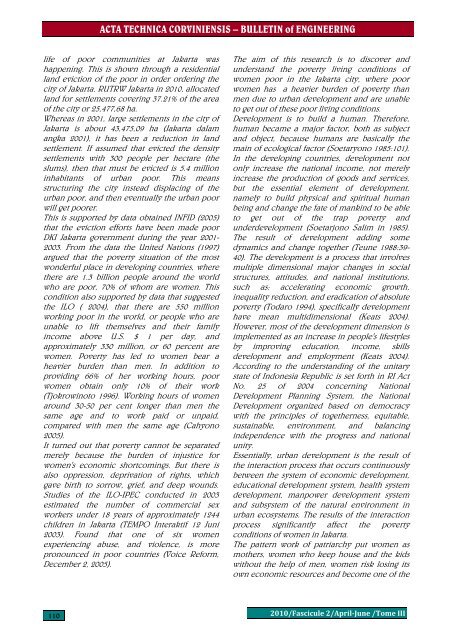ACTA TECHNICA CORVINIENSIS - Bulletin of Engineering
ACTA TECHNICA CORVINIENSIS - Bulletin of Engineering
ACTA TECHNICA CORVINIENSIS - Bulletin of Engineering
- No tags were found...
Create successful ePaper yourself
Turn your PDF publications into a flip-book with our unique Google optimized e-Paper software.
<strong>ACTA</strong> <strong>TECHNICA</strong> <strong>CORVINIENSIS</strong> – BULLETIN <strong>of</strong> ENGINEERINGlife <strong>of</strong> poor communities at Jakarta washappening. This is shown through a residentialland eviction <strong>of</strong> the poor in order ordering thecity <strong>of</strong> Jakarta. RUTRW Jakarta in 2010, allocatedland for settlements covering 37.21% <strong>of</strong> the area<strong>of</strong> the city or 25,477,68 ha.Whereas in 2001, large settlements in the city <strong>of</strong>Jakarta is about 43,475,09 ha (Jakarta dalamangka 2001), it has been a reduction in landsettlement. If assumed that evicted the densitysettlements with 300 people per hectare (theslums), then that must be evicted is 5.4 millioninhabitants <strong>of</strong> urban poor. This meansstructuring the city instead displacing <strong>of</strong> theurban poor, and then eventually the urban poorwill get poorer.This is supported by data obtained INFID (2005)that the eviction efforts have been made poorDKI Jakarta government during the year 2001-2003. From the data the United Nations (1997)argued that the poverty situation <strong>of</strong> the mostwonderful place in developing countries, wherethere are 1.3 billion people around the worldwho are poor, 70% <strong>of</strong> whom are women. Thiscondition also supported by data that suggestedthe ILO ( 2004), that there are 550 millionworking poor in the world, or people who areunable to lift themselves and their familyincome above U.S. $ 1 per day, andapproximately 330 million, or 60 percent arewomen. Poverty has led to women bear aheavier burden than men. In addition toproviding 66% <strong>of</strong> her working hours, poorwomen obtain only 10% <strong>of</strong> their work(Tjokrowinoto 1996). Working hours <strong>of</strong> womenaround 30-50 per cent longer than men thesame age and to work paid or unpaid,compared with men the same age (Cahyono2005).It turned out that poverty cannot be separatedmerely because the burden <strong>of</strong> injustice forwomen's economic shortcomings. But there isalso oppression, deprivation <strong>of</strong> rights, whichgave birth to sorrow, grief, and deep wounds.Studies <strong>of</strong> the ILO-IPEC conducted in 2003estimated the number <strong>of</strong> commercial sexworkers under 18 years <strong>of</strong> approximately 1244children in Jakarta (TEMPO Interaktif 12 Juni2003). Found that one <strong>of</strong> six womenexperiencing abuse, and violence, is morepronounced in poor countries (Voice Reform,December 2, 2005).The aim <strong>of</strong> this research is to discover andunderstand the poverty living conditions <strong>of</strong>women poor in the Jakarta city, where poorwomen has a heavier burden <strong>of</strong> poverty thanmen due to urban development and are unableto get out <strong>of</strong> these poor living conditions.Development is to build a human. Therefore,human became a major factor, both as subjectand object, because humans are basically themain <strong>of</strong> ecological factor (Soetaryono 1985:101).In the developing countries, development notonly increase the national income, not merelyincrease the production <strong>of</strong> goods and services,but the essential element <strong>of</strong> development,namely to build physical and spiritual humanbeing and change the fate <strong>of</strong> mankind to be ableto get out <strong>of</strong> the trap poverty andunderdevelopment (Soetarjono Salim in 1985).The result <strong>of</strong> development adding somedynamics and change together (Teune 1988:39-40). The development is a process that involvesmultiple dimensional major changes in socialstructures, attitudes, and national institutions,such as: accelerating economic growth,inequality reduction, and eradication <strong>of</strong> absolutepoverty (Todaro 1994), specifically developmenthave mean multidimensional (Keats 2004).However, most <strong>of</strong> the development dimension isimplemented as an increase in people's lifestylesby improving education, income, skillsdevelopment and employment (Keats 2004).According to the understanding <strong>of</strong> the unitarystate <strong>of</strong> Indonesia Republic is set forth in RI ActNo. 25 <strong>of</strong> 2004 concerning NationalDevelopment Planning System, the NationalDevelopment organized based on democracywith the principles <strong>of</strong> togetherness, equitable,sustainable, environment, and balancingindependence with the progress and nationalunity.Essentially, urban development is the result <strong>of</strong>the interaction process that occurs continuouslybetween the system <strong>of</strong> economic development,educational development system, health systemdevelopment, manpower development systemand subsystem <strong>of</strong> the natural environment inurban ecosystems. The results <strong>of</strong> the interactionprocess significantly affect the povertyconditions <strong>of</strong> women in Jakarta.The pattern work <strong>of</strong> patriarchy put women asmothers, women who keep house and the kidswithout the help <strong>of</strong> men, women risk losing itsown economic resources and become one <strong>of</strong> the1102010/Fascicule 2/AprilJune /Tome III
















